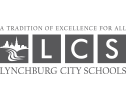When the final bell of the school day rings, the hallways of E. C. Glass and Heritage high schools buzz with excitement. Students flood into classrooms, auditoriums, and lecture halls, ready to connect with their peers and explore new realms of knowledge. It’s time for school club meetings.
Over the next hour, students will grow plants, paint murals, learn new languages, perform monologues, play chess, plan school events, and more. We popped into a sampling of club meetings to learn more about how these groups provide unique opportunities for extracurricular learning, student leadership, and community building.
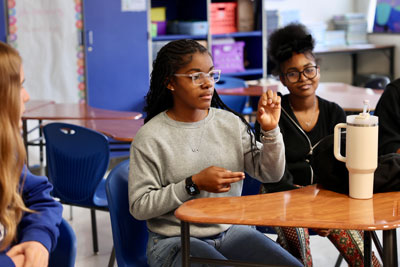
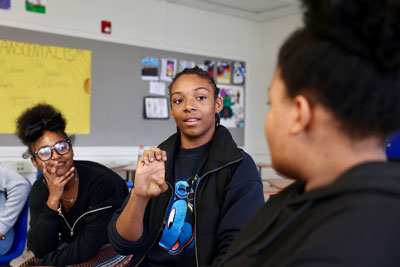
ASL Club
On a rainy Thursday afternoon, E. C. Glass High School tenth grader Mila Boyd pulled up “This is Halloween” from “The Nightmare Before Christmas” on YouTube. Together, the American Sign Language (ASL) club signed along to the music. They’d been practicing for weeks to keep up with the fast pace and learn new vocabulary words from the lyrics.
“I’ve been learning ASL since elementary school. I’ve since started raising awareness about the deaf community and teaching people what I know,” Boyd said. “I love the language. I love learning new signs and teaching others.”
Boyd has been leading the weekly ASL club for a year now, drawing from her expansive knowledge of the language to lead beginner-friendly vocabulary and grammar lessons. Since starting the club, she’s brought together a community of students who share her love for the language.
“Clubs like this one offer students an opportunity to learn about different things they are not necessarily going to be exposed to in a classroom and socialize outside of their comfort zones,” said Bert Mueller, the club’s faculty sponsor.

E. C. Glass tenth grader Mila Boyd leads her peers in an ASL interpretation of Danny Elfman’s “This is Halloween.”
Aquaponics & Environmental Club
The first thing that catches the eye when one enters Heritage High biology teacher Cathy Drumheller’s classroom is the giant aquaponics system near the window. Healthy heads of lettuce grow out of a bubbling tank, filtering the water for the fish below while soaking up the nutrients the fish deposit. Students in the aquaponics and environmental club tend to the little ecosystem with care, learning about urban agriculture and environmental science in the process.

Heritage High 11th grader Lyndon Bierlein (left) monitors the aquaponics system with another club member.
Eleventh grader Lyndon Bierlein’s experiences with the aquaponics system inspired him to investigate a similar topic for his Central Virginia Governor's School for Science & Technology research project. His experiment, which will be entered into the Central Virginia Regional Science Fair with opportunities to advance to the international competition, will test whether fertilizer or composting introduces more nitrogen to soil.
“I’ve had fun doing this, so I wanted to dig deeper with my research project,” Bierlein said. “Before joining, I’d never had the opportunity to start a garden or learn about plant fertility. I hadn’t realized how much goes into growing plants.”
Creative Arts Club
Creeping across the windows and walls of E. C. Glass teacher Todd Doremus’ classroom are the beginnings of the creative art club’s latest endeavor, a colorful mural depicting various nature scenes. As students mix paint shades and sketch out new sections of the mural, there’s a sense that they’re part of something bigger than themselves. Their art will leave a mark on the school long after current club members graduate.
“Future freshmen are going to build off of what we’ve created and have a whole different experience with the art,” said tenth grader Jaidyn Boogades.

Creative arts club members show off their mural, which they’ll continue to work on throughout the year.
“The Pioneer” Literary Magazine
At Heritage High School, “The Pioneer” literary magazine also provides an outlet for creative expression. Students can submit original artwork, photography, poetry, and prose to the student-run magazine for online publication.
“Getting published in the magazine helps get students into writing and lets them know their work is valuable. Their stories and art are important to share,” said faculty sponsor Michelle Hensley.
Elaina Howard, a tenth grader at Heritage High, splits editing duties with her fellow magazine staff members, providing constructive feedback to writers and getting submissions ready for publication. Their process is designed to imitate that of a professional creative magazine.
“Editing is one of my favorite things. It improves my writing abilities and helps me explore different voices and ways to get my point across,” said Howard, who hopes to pursue a career in publishing after graduation.

E. C. Glass tenth grader Jaidyn Boogades and other creative arts club members work on a set for an upcoming school theatre production.
Redux Threads Club
At E. C. Glass, members of the new Redux Threads club express themselves through a different medium: textile design and production. Faculty sponsor Patricia Finn-Rapiejko taught Family and Consumer Sciences (FACS) at Sandusky Middle School before becoming an English teacher at E. C. Glass. A certified Career and Technical Education (CTE) instructor, she works one-on-one with students to help them develop foundational skills as they create and mend garments with a focus on upcycling and sustainability.
“You don’t see as much handmade clothing nowadays compared to back then. The art of making your own clothes has kind of faded out,” said tenth grader Lucas Miller. “It’s important to bring it back. When you make things yourself, you can create items you’re not going to see anywhere else and express yourself in new ways.”
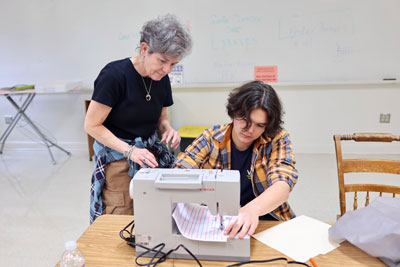
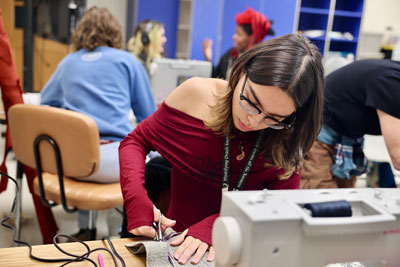
Members of the Redux Threads club learn sewing skills and work independently on projects with the guidance of faculty sponsor Patricia Finn-Rapiejko (left).
Baking Club
Across town at Heritage High, students dabble in culinary arts through the baking club. Formed this year by twelfth graders Paisley Hobson and Brandon Billups, it’s quickly become one of the most popular after-school activities.
“Baking is an art. Sharing baked goods with friends teaches people not to be afraid to show off their creativity and put their art out into the world,” said Hobson, who runs a small business selling art and baked goods on the side and hopes to someday work as a professional chef.
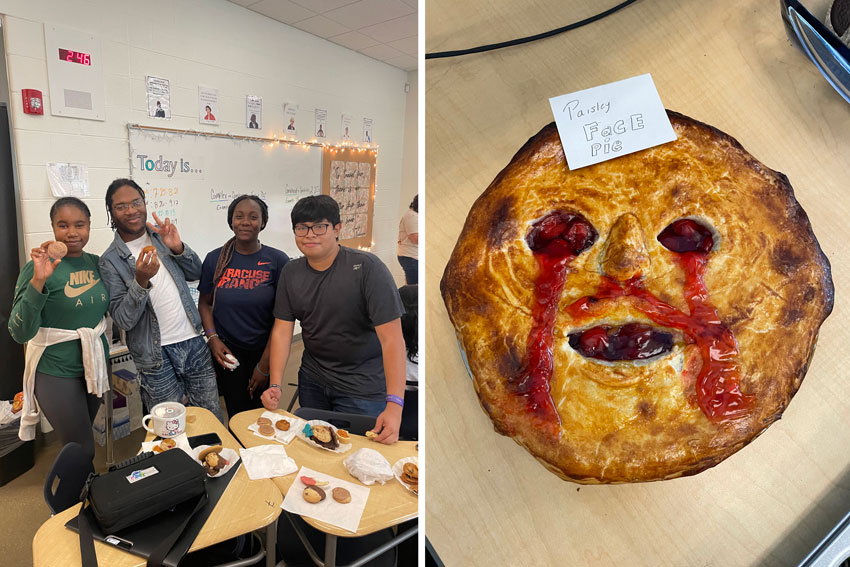
Left: Students try each other’s baked treats. Right: Club co-founder Paisley Hobson shows off her presentation skills at a Halloween-themed meeting.
Students bring baked goods to share at meetings, swapping words of encouragement and technical tips as they enjoy each other’s creations. The supportive atmosphere and deep sense of community are contagious.
“I’ve seen students who are normally shy and quiet coming out of their shells through this club. They’re so excited about what they’re going to bake next,” said faculty sponsor Cady Cordle. “Even students who aren’t involved in things like sports, band, or choir find a home here. It’s important for everyone to have a place to feel included and make friends.”

Student Leadership
At E. C. Glass High School, members of the Student Council Association (SCA) organize activities like homecoming, pep rallies, spirit weeks, candy gram sales, donation drives for community organizations, and more. The club’s counterpart at Heritage High School carries out a similar function through a student leadership class. At both schools, students take charge of the process, planning and executing each activity from start to finish.
“It pushes you out of your comfort zone and allows you to interact with people you wouldn’t normally meet and do things you wouldn’t normally do. You learn leadership, communication, time management, and workforce skills,” said 11th grader Briyonna Tune, who leads the Heritage High student section.
Student activities form the backbone of school social life, connecting classmates over a shared sense of school spirit and orchestrating memories they’ll hold onto forever. They add color to the high school experience, motivating students to show up as their best selves every day.
“You’re more likely to be excited about coming to school if you feel like it’s a safe, positive place. Student activities create a better overall high school experience for everyone,” said E. C. Glass 11th grader and SCA president Mary Stone.

E. C. Glass SCA students prepare for homecoming. Photo by E. C. Glass twelfth grader Lucy White for “The Crest” yearbook.
Why Clubs Matter
At both E. C. Glass and Heritage high schools, diverse networks of clubs form the epicenter of high school culture and provide opportunities for students to learn outside the classroom. There’s something for everyone: dance club, gardening club, National Honor Society, forensics, JROTC drill team, German club, competitive CTE groups like SkillsUSA, and more. And if a club doesn’t exist, students are free to create their own.
“When I get older, I want to have memories to look back on from high school,” said E. C. Glass tenth grader Lucas Miller. “Clubs are such an important part of the experience because they help you try new things, meet new people, and figure out what you want to do when you’re older. They’re a part of growing into who you want to be.”
